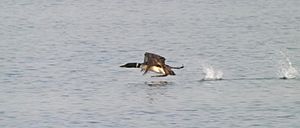Common loon facts for kids
Quick facts for kids Common loon |
|
|---|---|
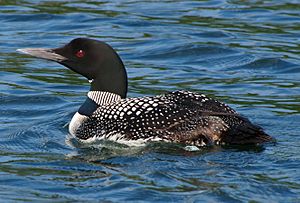 |
|
| An adult loon in its breeding colors in Wisconsin | |
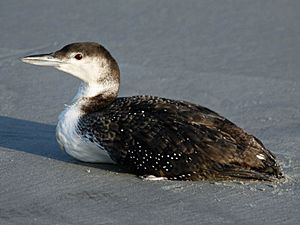 |
|
| A loon in its non-breeding colors in North Carolina | |
| Conservation status | |
| Scientific classification | |
| Genus: |
Gavia
|
| Species: |
immer
|
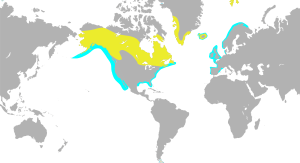 |
|
| Where the common loon lives
Breeding range Wintering range |
|
| Synonyms | |
|
|
The common loon (Gavia immer), also called the great northern diver, is a large water bird. It belongs to the loon family. When they are ready to breed, adult loons have a black head and neck. These parts can shine with green, purple, or blue. Their back is dark, and their belly is pure white. Loons that are not breeding look brownish. Their head and neck are dark grey-brown. Males and females look alike, but males are heavier.
During the breeding season, loons live on lakes in Canada and the northern United States. They also live in parts of Greenland and Iceland. A few even breed in Svalbard and other Arctic areas. In winter, common loons fly to the coasts of the US and Mexico. They also go to the Atlantic coast of Europe.
Common loons eat many different animals. Their diet includes fish, crabs, insect larvae, and snails. Sometimes they eat water plants too. They usually swallow their food underwater. But they bring bigger items to the surface first. Loons are monogamous, meaning a male and female often stay together. They defend their territory and may breed together for ten years or more.
Both parents build a large nest from dead marsh grasses. They make a mound along the lake shores. They raise one group of chicks each year. A female lays one or two olive-brown eggs with dark spots. Both parents sit on the eggs for about 28 days. The chicks are fed by both parents. They learn to fly in 70 to 77 days. Young loons can dive underwater when they are only a few days old. They fly to their winter homes before the lakes freeze.
The common loon is listed as a species of least concern by the IUCN Red List. This means it is not in danger of disappearing. It is also protected by an agreement for migratory waterbirds. The United States Forest Service considers it a special status species. This is because it faces threats like losing its habitat and poisoning from metals.
The common loon is the official provincial bird of Ontario, Canada. It is shown on Canadian money, like the one-dollar "loonie" coin. It was also on older $20 bills. In 1961, it became the state bird of Minnesota. You can see it on the Minnesota State Quarter.
Contents
About the Common Loon
The common loon is also known as the great northern diver in Eurasia. It is one of five loon species. These birds belong to the Gavia genus. This is the only genus in the Gaviidae family. Its closest relative is the yellow-billed loon (Gavia adamsii). There are no different types (subspecies) of the common loon.
A Danish zoologist named Morten Thrane Brünnich first described the common loon in 1764. He called it Colymbus immer. The name Colymbus used to include both grebes and loons. But in 1956, scientists decided to use Gavia for loons. This name was created by Johann Reinhold Forster in 1788.
The name Gavia comes from a Latin word for a seabird. The word immer comes from a Norwegian name for the bird. It is similar to the Icelandic word "himbrimi." It might also be linked to words meaning "dark ashes" (for its dark feathers) or "to immerse" (for its diving).
The European name "diver" comes from how the bird catches fish by diving. The North American name "loon" was first written down in 1634. It might come from an Old Norse word lómr. This word refers to the loon's special call.
What Does a Common Loon Look Like?
An adult common loon can be 66 to 91 centimeters (26 to 36 inches) long. Its wingspan is about 127 to 147 centimeters (50 to 58 inches). On average, it is about 81 cm (32 in) long. Its wingspan is about 136 cm (54 in). It can weigh from 2.2 to 7.6 kilograms (4.9 to 16.8 pounds). Loons from different areas can vary in size. Males are often much heavier than females. For example, males in Maine average 5.97 kg (13.2 lb). Females average 4.65 kg (10.3 lb).
When breeding, loons have a black head and neck. These parts can have a green, purple, or blue shine. Their bill is black, sometimes with a pale tip. Their eyes are red. They have a black ring around their neck. There are two white "necklaces" of streaks on their upper neck. A white collar with parallel lines forms a large oval on the neck-side. The lower front of the neck is white. The sides of the lower neck have white lines and black lines.
The loon's back is blackish or dark grey. Each feather has small white spots. Their upper wings are blackish with small white spots. Their underwings are paler. The loon's belly is pure white. But there is some black on the feathers under its tail. It has a checkered black-and-white pattern on its back. Its tail is blackish. Its legs are pale grey on the inside and blackish on the outside. The webs between its toes are flesh-colored.
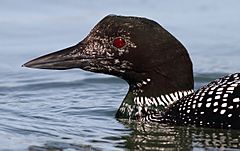
When not breeding, adults are brownish. Their neck and head are dark grey-brown. White surrounds their eyes. Their bill is mostly pale grey. The belly, lower face, chin, and throat are whitish. The front of the neck is whitish. This often forms a V-shape in the dark neck. The back is dark brownish-grey. It has an unclear pattern of squares on its shoulders. Some wing feathers have white spots. Males and females look similar, but males are larger and heavier.
The loon's bill is heavy and shaped like a dagger. It is evenly tapered and greyish. Sometimes it has a black tip. The color and angle of the bill help tell it apart from the yellow-billed loon. Its neck is short and thick. It swims very low in the water. Sometimes only its head is above the water. To fly, it needs a long run across the water. On land, it is clumsy. It slides on its belly and pushes itself with its legs. This is because its legs are at the very back of its body. This is great for swimming but not for walking. When it lands on water, it skims on its belly to slow down.
Loons have solid bones. Most flying birds have hollow bones to be lighter. But solid bones help loons dive deep.
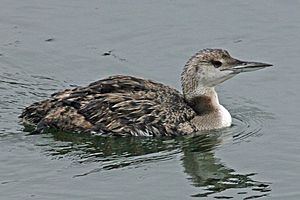
Young loons often have a dark, brownish-grey nape (back of the neck). Their head, neck, and back are dark grey to black. Their throat, cheeks, and belly are white. In their first winter, their bill might not be fully grown. By their second winter, they look much like breeding adults.
The common loon is bigger than the black-throated loon and the red-throated loon. It usually has a steeper forehead. Its bill is heavier, and its back is paler than its hindneck. It is harder to tell apart from the yellow-billed loon. But the common loon has more white marks on its neck when breeding. The squares on its shoulders are usually smaller. When not breeding, its neck sides are darker. This makes a sharper contrast with the pale areas.
Changing Feathers (Moult)
Young loons keep their first feathers until January or February. Then they shed their head and body feathers. This makes them look more like adults. Adult loons shed all their flight feathers at once around this time. This means they cannot fly for a while. Then they grow their breeding feathers. But two-year-old birds wait until summer for this big feather change. Adults get their winter feathers between October and January. This happens by shedding some head, body, and tail feathers.
Where Common Loons Live
Common loons mainly live in North America. They breed from 48° N up to the Arctic Circle. This includes the northern United States and Canada. They also breed in southern Greenland, Iceland, Svalbard, and Jan Mayen. Their summer homes are wooded lakes and tundra ponds. The lakes need to be big enough for them to take off flying. They also need many small fish. Loons prefer deep, clear lakes with warm surface water. This helps them see their prey. Lakes with islands and coves offer protection from predators. Loons often return to the same breeding spots each year.
Some common loons stay in Iceland all year. But most migrate. In North America, they spend winter along the Atlantic and Pacific coasts. Many stop at the Great Lakes during their journey. They fly during the day, high in the sky. Their flying speed can be up to 120 km/h (75 mph). In winter, they can be seen as far south as Baja California in Mexico. In Europe, thousands winter along the western coasts. These birds likely come from Iceland, Greenland, and Canada. Their winter range goes from Finland to Portugal. A few even go as far south as Morocco in Africa.
They usually winter along coasts and on inland lakes. They go to the nearest unfrozen water. Western Canadian loons go to the Pacific. Great Lakes loons go to the Gulf of Mexico. Eastern Canadian loons go to the Atlantic. Some go to large inland lakes. The coasts of South Carolina, the Florida Panhandle, and the Atlantic from Massachusetts to Maine have many loons. Sometimes, loons are seen in unexpected places. These include inland Mexico and even Japan.
How Common Loons Behave
The common loon is an excellent fisher. It catches prey underwater by diving up to 60 meters (200 feet) deep. Its large webbed feet help it swim fast underwater. It is a very good diver. But it needs a long run-up on the water to take off flying. On land, it is clumsy. It slides on its belly and pushes itself with its legs. This is because its legs are at the very back of its body. This is perfect for swimming but not for walking. When it lands on water, it skims on its belly to slow down.
Loons swim and dive well. They fly hundreds of kilometers during migration. When flying, their neck is stretched out. They often make a special tremolo call. This call helps identify a flying loon.
What Common Loons Eat
Fish make up about 80% of the common loon's diet. They eat fish up to 26 cm (10 in) long. This includes minnows, suckers, rock bass, and northern pike. Young loons usually eat small minnows. They sometimes eat insects and bits of green plants. In freshwater, they mainly eat pike, perch, sunfish, and trout. In saltwater, they eat rock fish, flounder, and herring.
If fish are scarce, loons eat other things. These include crabs, crayfish, snails, leeches, and insect larvae. They also eat molluscs, frogs, and annelids. Sometimes they eat water plants like pondweed and algae. They have even been known to eat ducklings.
The common loon uses its strong back legs to swim fast underwater. It catches its prey and swallows it head-first. If a fish tries to get away, the loon chases it. It is very good at moving underwater. Most prey are swallowed underwater. But larger prey are brought to the surface first. Loons hunt by sight. So, clear water is very important for them. They usually dive 4 to 10 meters (13 to 33 feet) deep. But they have been seen diving up to 70 meters (230 feet). On average, they stay underwater for 42 seconds. The longest they can stay underwater is about one minute.
Common Loon Life Cycle and Reproduction
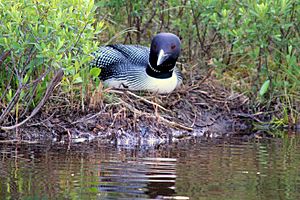
Common loons are monogamous during the breeding season. A male and female pair defend a territory. This can be a whole small lake or a protected bay in a large lake. They stay together to raise their chicks. They often return to the same breeding spot each spring. They may breed together for many years. However, if one loon dies or is forced out, the other loon will find a new mate. Younger loons (5 to 9 years old) often take over territories from older loons (15 years and older).
Loons do not stay together in winter. Males usually arrive at the breeding lakes before females. They settle once the ice melts. Mating happens on land, often at the nest site. It happens daily until the eggs are laid. Their courtship is simple. They dip their bills and dive together.
Nesting usually starts in early May. More nests are found on islands than on the shoreline. Breeding pairs patrol their territory day and night. They defend it with their bodies and calls. Pairs that had successful chicks last year often use the same nest site. But if predators ate their eggs, they usually move the nest. Males seem to lead in choosing the nest site. But both parents help build the nest.
The nest is about 56 cm (22 in) wide. It is made of dead marsh grasses and other plants. It forms a mound along the vegetated shores of lakes. After about a week of building, one parent sits on top. This shapes the inside of the nest to fit its body. About 40% of nests are successful. Most newly hatched chicks survive because their parents care for them.
Eggs are usually laid in May or early June. The timing depends on when the lakes become ice-free. A female lays two (sometimes one) olive-brown eggs with dark spots. The eggs are about 88 mm (3.5 in) long and 55 mm (2.2 in) wide. The two eggs are laid one to three days apart. Both parents take turns sitting on the eggs for about 28 days. Loons often build nests on steep lake shores. This lets them dive underwater quickly if predators come near.
New chicks are dark chocolate brown with a white belly. Within hours of hatching, they leave the nest with their parents. They swim close by and sometimes ride on a parent's back. Parents and chicks stay in shallow, quiet bays at first. This helps parents defend them from other loons and eagles. Eagles are a main predator. Male parents defend two chicks more strongly than one chick. Chicks can make shallow dives from their first day. They dive deeper as they grow. Chicks learn to fly in 70 to 77 days. Usually, only one group of chicks is raised per year.
Both parents feed the chicks live prey from hatching until they can fly. As they grow, chicks catch more of their own food. They can feed themselves after about two months. But many young loons still beg for food from adults after this. Parents catch small fish and hold them sideways in their bill. They call to the chicks and lower their head so the chicks can grab the fish. If food is scarce, the larger chick might peck its smaller sibling. On small lakes with little food, often only one chick survives. Young loons leave the breeding ground before the ice forms in the fall. This is weeks after their parents leave. A pair of loons raising two chicks might eat 423 kg (933 lb) of fish during their five and a half months on the breeding lake.
Loon Calls and Sounds (Vocalizations)
The common loon makes many different sounds. The most common are the tremolo, the yodel, the wail, and the hoot. Each call has a different meaning. How often they call depends on the time of day, weather, and season. They are most vocal from mid-May to mid-June. The wail, yodel, and tremolo calls are heard more at night. They also call more often in cold weather and when there is little rain.
The tremolo call is sometimes called the "laughing" call. It is short and wavering. Loons use it to show distress or alarm. This can be from fights over territory or perceived dangers. It sounds like a shaky series of high notes: (hu)-heheheheheheha. They also use the tremolo to let other loons know they are there. This happens when other loons fly overhead. It is the only call they use while flying. The tremolo call has three levels of intensity. These show how distressed the loon is. Higher pitches mean more distress.
The yodel is a long, complex call made only by the male. It is used to mark territory and during fights over territory. The longer the call, the more aggressive the loon is. The main sounds in the yodel show the male's body size and health. A male taking over a new territory seems to change its yodel. This makes it sound different from the previous owner's call.
A loon's wail is a long call with up to three notes. It is often compared to a wolf's howl. Loons use this call to tell other loons where they are. Breeding pairs or a parent and chick use it to stay in contact. Or they use it to move closer after being separated. It sounds like a loud aaoo, weee-wea weee-wea weee-wea, or ooo-aaah-éééé.
The hoot is a short, soft call. It is another way loons keep in touch. It is a more private call than the wail. It is used only between small family groups or flocks. The common loon hoots to let other family members know where it is. This call is often heard when an adult loon calls its chicks to feed.
How Long Do Loons Live?
Scientists have learned a lot about how long loons live. They found that common loons usually live for over 90% of their lives until they are in their mid-20s. After that, their survival rate drops to about 75%. However, a closer look showed that male loons start to have more deaths, lose their territory, and be less healthy after age 15. Perhaps because they are getting older, males 15 and older become more aggressive. They also make more territorial calls. This change in behavior is like a "go for broke" strategy. Older animals do this to try and breed for another year or two before they die.
Who Hunts Loons and What Harms Them?
Adult common loons have few predators. But bald eagles will attack loons sitting on their nests. Sharks have also attacked loons in winter. If a predator comes near a loon or its nest, the loon might attack. It rushes at the predator and tries to stab it with its sharp bill. It aims for the predator's belly or the back of its head or neck. This can be deadly for predators like foxes or raccoons.
Many mammals eat loon eggs. These include American mink, striped skunk, otters, foxes, and raccoons. Raccoons cause almost 40% of all nest failures. Birds like herring gulls, ravens, and American crows will eat eggs left alone. Since nests are at the water's edge, loon eggs are very vulnerable if the adult is away.
Chicks can be killed by common snapping turtles, large gulls, bald eagles, and large fish. These fish include northern pike and largemouth bass. Eagles are a big threat to chicks.
Loons can get internal parasites like many types of worms. These include flatworms, tapeworms, nematodes, and spiny-headed worms. Too many worms can make loons sick or even kill them. This might happen if they can't find enough fish to eat. They can also get infections from tiny organisms. The black fly Simulium annulus is attracted to loons. These flies can harm loons by spreading diseases. They can also cause loons to leave their nests if there are too many flies. Loons can also get feather lice.
Loons can get Botulism from eating infected fish. This can cause paralysis and drowning. Aspergillosis is another disease that can make them thin and die. Sometimes, many loons die from these outbreaks.
Loon Status and Protection
Since 1998, the common loon has been listed as a species of least concern on the IUCN Red List. This means it is not currently in danger. It lives in a very large area. Its population is stable. There are 612,000 to 640,000 loons. In Europe, there are 1,400 to 2,600 breeding loons. Over half of North America's breeding loons are in Ontario (97,000 pairs) and Quebec (50,000 pairs). Alaska has 3,600 to 6,000 breeding pairs. The U.S. Great Lakes region has 5,900 to 7,200 breeding pairs.
The common loon is protected by international agreements. It is listed in Appendix II of the Convention on the Conservation of Migratory Species of Wild Animals. It is also part of the Agreement on the Conservation of African-Eurasian Migratory Waterbirds (AEWA). In Europe, it lives in 20 Important Bird Areas. The USDA National Forest Service calls the common loon a species of special status.
Threats to Loons
Pollution and Loons
Pollution from mercury and acid rain is a big threat to loons. These pollutants affect how well loons reproduce. In the upper United States and lower Canada, lake acidity increases from west to east. This is likely from burning fossil fuels. These fuels release mercury and other harmful parts of acid rain. Acid rain makes lakes more acidic. This can reduce important elements like calcium. It also increases toxic metals like mercury and lead.
Mercury is often found as methylmercury in nature. Acid rain and mercury levels in water are linked. More acid rain means more sulfur oxides. These help bacteria create more methylmercury. Mercury levels are also linked to pH. Higher pH means lower mercury levels. Methylmercury moves up the food chain. Animals at the top, like loons, are most affected. For loons, mercury levels in fish are linked to mercury levels in loon blood. As mercury in fish goes up, so does mercury in loons. This happens as pH goes down.
Male loons tend to have the highest mercury in their blood. This is because they eat bigger fish with more mercury. Females have the second highest. They can pass some mercury into their eggs. Young loons have the lowest mercury. Their levels best show how much mercury is in their home lake. This is because they only eat food from their birth territory.
High mercury levels can change how adult loons find food. It also affects how they care for their chicks. Studies show that high mercury levels harm reproduction. One study found that if female loons had too much mercury, they had half as many chicks. If mercury levels were even higher, they had no chicks at all. As mercury levels and pH are linked, success in raising chicks decreases with lower pH.
Many loons are at high risk from mercury. A study in New York showed 21% of males and 8% of females were at high risk. In Quebec, Canada, 33% of loons tested were at high risk. Even though acid rain emissions have gone down, lakes have not fully recovered. This is likely due to climate change. Warmer summers can stop cold-water fish from returning to acidic lakes. Droughts from warmer temperatures can make lakes even more acidic.
Loon Breeding Areas Shrinking
The common loon's breeding range has moved northward. A century ago, they bred as far south as Iowa. They are also harmed by acid rain and pollution. Lead poisoning from fishing weights is a problem. Especially weights the size of the small stones loons swallow. Mercury contamination from industry also harms them. Heavy metals can be removed from the body. But their harmful effects are magnified in organs like the liver. Eggshells can also have metal contaminants. This leads to fewer successful chicks. High levels of heavy metals are linked to loons being in poor health. Males are affected more because they eat larger fish.
The common loon's breeding range has also shrunk due to hunting and predators. Changing water levels, or flooding, also hurt them. Some people try to help loons by putting out floating nests. These platforms reduce the impact of changing water levels from dams. Loons leave lakes that do not have good nesting spots due to human development. Personal watercraft and powerboats can drown chicks. They can also wash away eggs or flood nests. The loon is still considered an "injured" species in Alaska. This is because of the Exxon Valdez oil spill.
Loons in Culture
The loon's voice and looks are important in many Native American stories. The Ojibwe people have a story about a loon creating the world. The Micmac people tell of Kwee-moo, a loon who was a special messenger. The tale of the loon's necklace is told by many Pacific Coast peoples. The Delaware and the Buryats of Siberia also have creation stories with the loon.
Old names for the common loon include "big loon," "call-up-a-storm," and "hell-diver." In New England, it was called call-up-a-storm. People thought its loud cries meant a storm was coming. Some old Scottish names came from the sound of the bird's call. Others, like "bishop," were used to avoid older names for this bird.
People in the Scottish Islands ate common loons from ancient times until the 1700s. Their thick layer of fat was used as a medicine.
The common loon is on Canadian money. This includes the one-dollar "loonie" coin. It was also on older $20 bills. It is the official provincial bird of Ontario. In 1961, it became the state bird of Minnesota. It is also on the Minnesota State Quarter. The Major League Soccer team Minnesota United FC uses the loon in its logo.
The loon's wailing call is often used in movies and TV shows. It helps create a feeling of wilderness or suspense. It is also mentioned in songs.
This bird is key to the children's book Great Northern? by Arthur Ransome. In the story, children on holiday in Scotland see loons. They think they are great northern divers, which have not nested there before. An ornithologist confirms this. But he wants to steal the eggs and kill the birds. The story, published in 1947, shows conservationists winning against an egg collector.
In the 2016 Pixar movie Finding Dory, a loon named Becky helps two main characters. She uses a bucket to help Nemo and Marlin get into a marine life institute.
Loons are also important in the 1981 film On Golden Pond.
Images for kids
See also
 In Spanish: Colimbo grande para niños
In Spanish: Colimbo grande para niños




